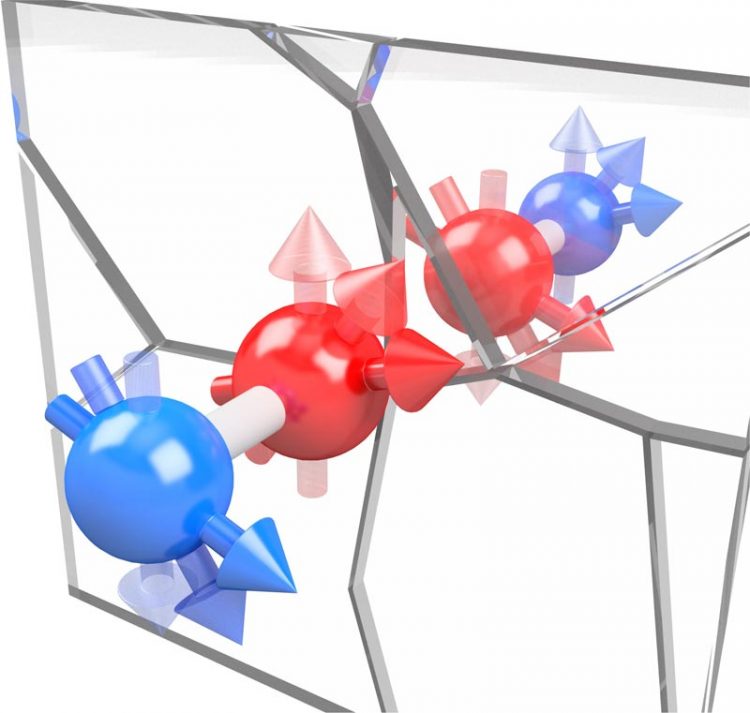The broken mirror: Can parity violation in molecules finally be measured?

Schematic illustration of parity violation in a molecule containing two nuclear spins ©: Dr. John W. Blanchard
Scientists have long tried to experimentally demonstrate a certain symmetry property of the weak interaction – parity violation – in molecules. So far, this has not been possible.
A new interdisciplinary effort led by a research group at the at the PRISMA⁺ Cluster of Excellence at Johannes Gutenberg University Mainz (JGU) and the Helmholtz Institute Mainz (HIM) has now shown a realistic path to demonstrating this phenomenon.
The approach includes aspects of nuclear, elementary particle, atomic and molecular physics as well as nuclear magnetic resonance (NMR). “Molecular parity nonconservation in nuclear spin couplings” is published in the current issue of the journal Physical Review Research.
Symmetries are omnipresent – in space as well as in the world of molecules, atoms and elementary particles. The four fundamental forces (electromagnetism, gravity, and the strong and weak nuclear forces) also obey certain, perhaps seemingly abstract, symmetries.
From the Big Bang to the present day, existing symmetries were repeatedly broken. Symmetry and symmetry breaking are necessarily reflected in the physical processes and states that we can observe.
One of these symmetries is the mirror symmetry (symmetry with regard to reflection in space) – if it is broken, the researchers speak of parity violation. According to current knowledge, the weak interaction is the only one among the four fundamental forces that does not appear mirror-symmetrical:
Only in processes that are subject to this interaction do parity violations occur. “Since the weak interaction plays almost no role in our everyday experience – gravity and electromagnetism dominate here – the phenomenon of parity violation contradicts our normal idea and is therefore difficult to grasp,” says Dr. John Blanchard, lead author of the study.
“Parity violation in the weak interaction was therefore only theoretically predicted in the 1950s and was discovered shortly afterwards in certain nuclear and elementary particle decays. Parity-violating processes have never been detected in molecules, although theoretical calculations predict that they should be there. Definitive evidence of such subtle effects is, so to speak, a holy grail of precision-measurement physics.”
Many attempts have been made to experimentally observe the effects of parity violation in molecules. One example is the interaction of the spins of different atomic nuclei in a molecule. In turn, these can in principle be detected and analyzed using nuclear magnetic resonance methods (NMR). While the team of scientists has already developed a promising approach to chiral molecules in a previous work (https://doi.org/10.1103/PhysRevA.96.042119), their current publication focuses on simple molecules that consist of as few as two atoms.
First of all, they identify a special NMR measurement variable (a specific spin-spin coupling) on the basis of which the parity violation is shown and carry out complex theoretical analyses to calculate the expected effect within the molecule. These calculations were carried out in close collaboration with the co-author of the study, Prof. Mikhail G. Kozlov from the Nuclear Physics Institute in St. Petersburg, Russia, with whom the Mainz group has been working very successfully for many years.
Building on this, the scientists propose a special experiment that should be sensitive enough to detect the calculated signals: “The so-called ZULF (zero to ultra-low field) NMR method is an exotic technique that we were already using for dark matter successfully,” explains Prof. Dr. Dmitry Budker, also an author of the study. “It offers a system in which nuclear spins interact with each other more than with an external magnetic field. In this way, it enables the direct measurement of antisymmetric spin-spin couplings, which are cut off in conventional high-field NMR experiments.”
“Our results show an elegant way to quantitatively investigate the weak interaction in molecules and atomic nuclei,” concludes Dr. Blanchard. “The results of our feasibility study are very promising – we hope to soon have experimental verification of molecular parity nonconservation.”
Prof. Dr. Dmitry Budker
Quantum, Atomic and Neutron Physics (QUANTUM)
Institute of Physics and PRISMA+ Cluster of Excellence
Johannes Gutenberg-University Mainz
55099 Mainz
Tel. +49 6131 39-29630
Email: budker@uni-mainz.de
https://budker.uni-mainz.de/
Dr. John W. Blanchard
Helmholtz Institute Mainz / Johannes Gutenberg-University Mainz
55099 Mainz
Tel.: +49 6131 39-29632
Email: blanchard@uni-mainz.de
https://budker.uni-mainz.de/
John W. Blanchard, Jonathan P. King, Tobias F. Sjolander, Mikhail G. Kozlov, Dmitry Budker Molecular parity nonconservation in nuclear spin couplings
Physical Review Research (Vol. 2, No. 2 – 023258, 01 June 2020)
DOI: 10.1103/PhysRevResearch.2.023258
https://link.aps.org/doi/10.1103/PhysRevResearch.2.023258
Media Contact
All latest news from the category: Physics and Astronomy
This area deals with the fundamental laws and building blocks of nature and how they interact, the properties and the behavior of matter, and research into space and time and their structures.
innovations-report provides in-depth reports and articles on subjects such as astrophysics, laser technologies, nuclear, quantum, particle and solid-state physics, nanotechnologies, planetary research and findings (Mars, Venus) and developments related to the Hubble Telescope.
Newest articles

Properties of new materials for microchips
… can now be measured well. Reseachers of Delft University of Technology demonstrated measuring performance properties of ultrathin silicon membranes. Making ever smaller and more powerful chips requires new ultrathin…

Floating solar’s potential
… to support sustainable development by addressing climate, water, and energy goals holistically. A new study published this week in Nature Energy raises the potential for floating solar photovoltaics (FPV)…

Skyrmions move at record speeds
… a step towards the computing of the future. An international research team led by scientists from the CNRS1 has discovered that the magnetic nanobubbles2 known as skyrmions can be…





















